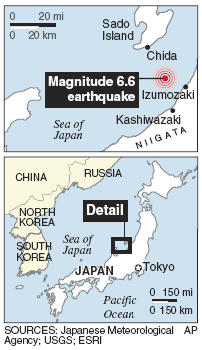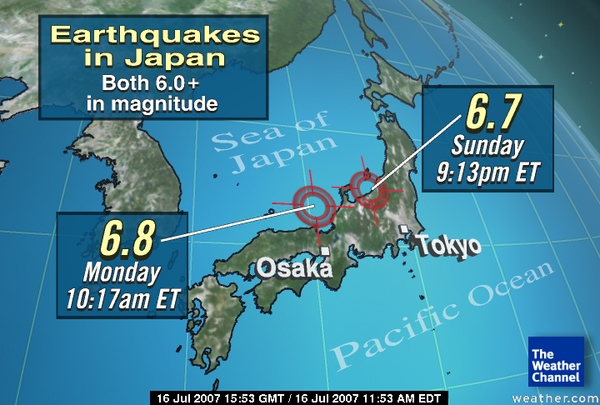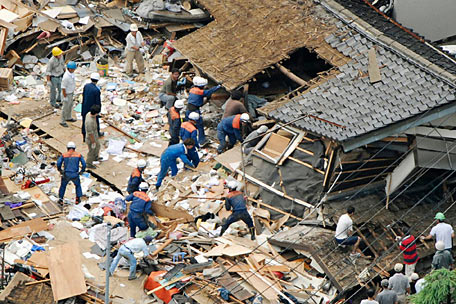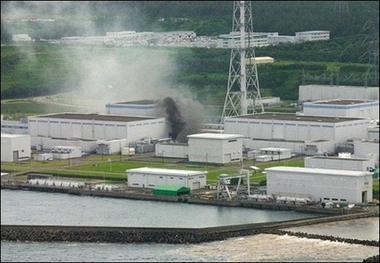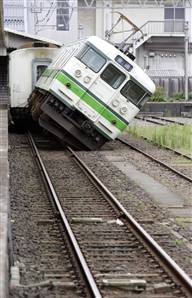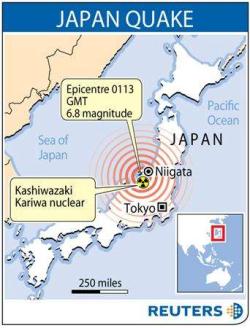Associated Press - July 15, 2007 10:43 PM ET
TOKYO (AP) - A strong earthquake has hit Japan.
The magnitude 6.6 quake caused buildings in
Tokyo to sway. At least 20 people were injured.
Officials say tsunamis as high as 20 inches have hit
coasts in the area.
Japanese broadcaster NHK says black smoke was
seen pouring from a nuclear plant, which was
automatically shut down. NHK reports the smoke was
caused by a fire in an electrical transformer, and
that no radioactivity had been released.
Authorities believe the earthquake was centered
off the northwest coast of Japan.
There are reports that several bullet train
services connecting Tokyo to northern Japan have been
suspended.
Copyright 2007 The
Associated Press.
|
|
|
|
Strong Quake Rocks Japan, Nuclear Plant
Jul 16 11:51 AM US/Eastern
By KOJI SASAHARA
Associated Press Writer
KASHIWAZAKI, Japan (AP) - A
strong earthquake struck northwestern Japan on Monday,
causing a fire and radioactive water leak at one of the world's
most powerful nuclear plants and turning buildings into piles of
lumber. At least seven people were killed and hundreds injured.
Flames and billows of black smoke poured from the Kashiwazaki
nuclear plant—the world's largest in terms of power output
capacity. It took two hours to extinguish the fire, at an
electrical transformer, said Motoyasu Tamaki, a Tokyo Electric
Power Co. official.
The plant leaked about a half-gallon of water, said Katsuya
Uchino, another Tokyo Electric official. Uchino said the water
contained a tiny amount of radioactive material—a billionth of
the guideline under
Japanese law—and is believed to have flushed into the
Sea of Japan.
The quake, which left fissures 3 feet wide in the ground
along the coast, hit shortly after 10 a.m. local time and was
centered off Niigata state. Buildings swayed 160 miles away in
Tokyo. Sirens wailed in Kashiwazaki, a city of about 90,000,
which appeared to be hardest hit.
Japan's Meteorological Agency measured the quake at a 6.8
magnitude. Near midnight Monday, another 6.8-magnitude quake hit
off Japan's west coast, according to the U.S. Geological Survey,
which said the initial quake registered 6.7.
"I was so scared—the violent shaking went on for 20 seconds,"
Ritei Wakatsuki, who was on her job in a convenience store in
Kashiwazaki. "I almost fainted by the fear of shaking."
Tokyo Electric said the water leak had stopped and that there
had been no "significant change" in the seawater under
surveillance and no effect on the environment, but the
developments at Kashiwazaki triggered fresh concern about the
earthquake resistance of Japan's nuclear power plants, which
supply nearly a third of the country's electricity.
Aileen Mioko Smith, of the environmentalist group Green
Action, said the fire showed that some facilities at nuclear
power plants such as electrical transformers were built to lower
quake-resistance levels than other equipment such as reactor
cores.
"That's the
Achilles heel of nuclear power plants," said Mioko Smith,
who said it took the plant two hours to extinguish the fire.
"Today's a good example of that... How prepared are they to put
out fires when they happen?
The quake hit on Marine Day, a national holiday in Japan,
when most people would have been at home.
Four women and three men—all either in their 70s or 80s—were
killed, according to the
National Police Agency in Tokyo and NHK, which reported more
than 800 people were hurt.
|
Nearly 300 homes in
Kashiwazaki—a city known mainly for its fishing
industry—were destroyed and some 2,000 people evacuated,
officials said.
A ceiling collapsed in a gym in Kashiwazaki where
about 200 people had gathered for a badminton
tournament, and one person was hurt, Kyodo reported. The
quake also knocked a
train car off the rails while it was stopped at a
station. No one was injured.
Several bullet train services linking Tokyo to
northern and northwestern Japan were suspended.
Prime Minister Shinzo Abe—whose ruling party is
trailing in the polls—interrupted a campaign stop in
southern Japan for upcoming parliamentary elections,
rushed back to Tokyo and announced he would head to the
damaged area. He later arrived in a blue uniform to
survey the damage.
"Many people told me they want to return to their
normal lives as quickly as possible," Abe told reporters
in Kashiwazaki. "The government will make every effort
to help with recovery."
Japan sits atop four tectonic plates and is one of
the world's most earthquake-prone countries. The last
major quake to hit the capital, Tokyo, killed some
142,000 people in 1923, and experts say the capital has
a 90 percent chance of suffering a major quake in the
next 50 years.
In October 2004, a magnitude-6.8 earthquake hit
Niigata, killing 40 people and damaging more than 6,000
homes. It was the deadliest to hit Japan since 1995,
when a magnitude-7.2 quake killed 6,433 people in the
western city of Kobe.
___
Associated Press writers Kozo Mizoguchi and Chisaki
Watanabe in Tokyo contributed to this report.
|
|
Reuters
Published: Monday, July 16, 2007
KASHIWAZAKI, Japan -- A second 6.8 magnitude
earthquake struck off the Japanese coast on Monday, the
U.S. Geological Survey reported, hours after a strong
earthquake flattened houses in northwestern Japan on,
killing at least seven people, and sparking a small
radiation leak and fire at the world's biggest nuclear
power plant.
More than 800 people were injured by the earlier
quake in Niigata prefecture, and buildings swayed as far
away as Tokyo. Thousands were evacuated from their homes.
Tokyo Electric Power Co (TEPCO) said 1.5 litres of
water containing radioactive materials had leaked from the
No. 6 unit at its Kashiwazaki-Kariwa nuclear power plant
-- the world's largest.
A 6.8 magnitude earthquake
struck off the Japanese coast on Monday, the U.S.
Geological Survey reported, hours after another quake of
similar strength killed at least seven people in Japan
and triggered a small leak of radioactive materials from
a nuclear plant.
The company said in a statement that the
contaminated water had been released into the ocean and
had had no effect on the environment. TEPCO said earlier
there were no radiation leaks at the plant, where reactors
automatically shut down for checks.
Two women in their 80s died when their houses
collapsed during the magnitude 6.8 tremor. A police
spokesman confirmed the deaths of seven elderly people,
and a 77-year-old man was reported missing after going for
a walk before the quake hit at 10:13 a.m. local time.
"First there was a sharp vertical jolt and then it
shook sideways for a long time and I couldn't stand up.
Tall shelves fell over and things flew around," said
Harumi Mikami, 55, a teacher who was at her school in
Kashiwazaki City, near the focus of the quake in Niigata
prefecture about 250 km northwest of Tokyo.
The quake halted gas service to about 35,000 homes
and disrupted the water supply to all of Kashiwazaki, a
city with a population of around 95,000 that was hardest
hit by the quake, media and officials said.
About 25,000 homes in Niigata prefecture were
without electricity, a local official said.
Houses, many wooden with traditional heavy tile
roofs, were flattened, a temple roof caved in and roads
cracked in the quake, which was centred in the same
northwestern area as a tremor three years ago that killed
some 65 people.
"My house is half destroyed and the pillars are
damaged," Ms. Mikami said. "My biggest worry is where I
will live now."
TV pictures showed an 84-year-old woman, apparently
alive, being rescued from the wreckage of her collapsed
house some five hours after the quake.
About 7,800 people had fled their homes to nearly
100 evacuation centres as scores of aftershocks of up to
magnitude 5.6 rattled the area, state broadcaster NHK
said.
Troops and extra emergency teams were being sent to
help with rescue and relief efforts, while Prime Minister
Shinzo Abe cut short campaigning for parliamentary
elections to inspect the area.
A fire in an electrical transformer at the
Kashiwazaki Kariwa nuclear power plant -- the world's
largest -- was quickly extinguished but it was unclear
when TEPCO could restart three power units there, said
Yoshinobu Kamijima, a company spokesman.
Abe's government set up an emergency office to deal
with the quake, which officials said had damaged about 500
buildings.
"People tell me they want to get back to their usual
lives as soon as possible," Abe said after arriving by
helicopter in Kashiwazaki. "We'll make every effort
towards rescue and also to restore services such as gas
and electricity."
Japan is one of the world's most earthquake-prone
countries, with a tremor occurring at least every five
minutes.
The first quake was centred around 60 km southwest
of Niigata. Monday was a holiday in Japan and financial
markets were closed.
Bullet trains stopped services in northern Japan
after the quake but resumed about 11 hours after the
quake. A local train toppled from the rails, but media
said no one was injured.
Landslides closed several local roads, and rain was
forecast in the area for the next two days, raising
worries about more slippage.
Soldiers brought tanks of water to Kashiwazaki and
were cooking rice for evacuees. "My house was totally
messed up and the only thing I could think of was to
escape and to take my kids to safety," said Itsuko
Igarashi, a housewife, at an evacuation centre in an
elementary school gymnasium in Kashiwazaki.
"It was shaking and scary," said her daughter, Sae,
aged 6.
Tsunami warning sirens sounded along affected
stretches of the Sea of Japan, but the alert was later
withdrawn.
Niigata was hit in October 2004 by a quake with a
matching magnitude of 6.8 that killed 65 people and
injured more than 3,000.
That was the deadliest quake in Japan since a
magnitude 7.3 tremor hit Kobe city in 1995, killing more
than 6,400.
Sanyo Electric Co. spokesman Akihiko Oiwa said
operations had been halted at a semiconductor factory in
Niigata, one of the company's largest, but there had been
no reports of damage.
N-plant's earthquake fail-safes worked / Small
amount of coolant leaked from power station, but
reactors shut down
7-17-07
The Yomiuri Shimbun
The reactors of Tokyo Electric Power Co.'s
Kashiwazaki-Kariwa nuclear power station
automatically shut down immediately after Monday's
powerful earthquake struck the area.
The Nos. 2, 3, 4 and 7 reactors shut down as
designed. The other three reactors were undergoing
periodic inspections at the time.
Soon after the magnitude-6.8 quake struck, a
fire broke out in a transformer at the No. 3
reactor facility, sending black smoke billowing
into the air.
The Economy, Trade and Industry Ministry
said no abnormal readings had been detected from
monitoring posts for radiation near the
transformer. But on Monday evening, TEPCO said it
had confirmed that a small amount of coolant
containing radioactive material had leaked at the
No. 6 reactor.
Shunsuke Kondo, professor emeritus at Tokyo
University, said: "It seemed the fire started in
the transformer, which provides electricity from
outside. I think insulation oil used for the
transformer caught fire."
According to Kondo, the black smoke
indicated insulation oil had ignited. Pipe joints
that provide insulation oil to transformers are
relatively weak, and Kondo said insulation oil
probably leaked from a joint and caught fire.
The quake was similar in size to the main
tremor of the Niigata Prefecture Chuetsu
Earthquake that struck on Oct. 23, 2004. But that
quake's epicenter was closer to bedrock and was
not intense enough to trigger an automatic
shutdown of the reactors.
The transmission of seismic energy of an
earthquake is very complicated and is greatly
influenced by the depth and location of an
earthquake's focus. The reactors' automatic
shutdown is believed to have functioned as
designed and not because of any imminent danger.
Only important facilities at the power plant
have strong quake resistance. Power plant
facilities and machines are divided into four
levels of importance. The lowest-level facilities,
including electric generators, are required to
have almost the same level of quake resistance as
ordinary buildings. The transformer that caught
fire probably was categorized as of low
importance.
"Quake-resistance standards for nuclear
power plants are set to be strengthened to handle
a catastrophic quake of a magnitude of 6.9, up
from a magnitude 6.5 under the old standards,"
Waseda University Prof. Masanori Hamada said.
"Nuclear power plants are designed with safety
allowances under these standards, meaning that
even if a quake over the standard occurs, there's
only a slight chance of an accident occurring."
Monday's quake magnitude came close to the
new standard. "So far, we can't say reviewing the
new standard will be necessary, but depending on
the result of analysis from an actual quake, the
standard might need to be reviewed," Hamada said.
===
Focus close to seabed
The earthquake was caused by the shifting of
a fault at a shallow part of the plate below the
Japanese archipelago, according to the
Meteorological Agency. The seismic focus was about
17 kilometers below the seabed of the Sea of Japan
off Kashiwazaki, Niigata Prefecture.
While the quake was the same
magnitude--6.8--as the 2004 Niigata Prefecture
Chuetsu Earthquake, in which 67 people died, a
different fault apparently shifted in this quake
because the focus was about 40 kilometers
northwest of that of the 2004 earthquake. As the
fault is located in a sea area, its existence had
not been known.
In Monday's earthquake, tremors measuring
upper 6 on the Japanese intensity scale of 7 were
recorded in Iizunamachi, Nagano Prefecture,
despite its distance from Kashiwazaki.
An earthquake occurring near the surface of
the Earth, including this earthquake, is referred
to as a "near-field" or "inland" quake. The 1995
Great Hanshin Earthquake in Hyogo Prefecture and
the Noto Peninsula Earthquake fall within this
category. As this type of temblor can occur
anywhere in the country, experts say areas that
were not hit by the latest quake should take heed
of the danger such quakes pose.
Under the plate on which the Japanese
archipelago sits, the Pacific Plate and the
Philippine Sea Plate are gradually sinking,
pushing the land-side plate northwest. "Due to the
strain energy within the land-side plate generated
in the process, weak ground breaks, triggering a
quake," an agency spokesman said.
(Jul. 17, 2007)
Quake/Nuclear Reactor
World's Biggest Nuke Plant Closed After Japan
Quake
Japan Hit By Second Quake - Atomic Reactor
Damaged
Japan Nuke Plant Leaked Into Sea After Quake
|
Major quake in Japan leaves
12,000 in shelters, aftershocks
warned
|
|
KASHIWAZAKI,
Japan, July 17, 2007 (Xinhua)
-- A major earthquake that rocked
Niigata prefecture and surrounding
areas in Japan on Monday has left
over 12,000 people in shelters by
Tuesday, with nine killed and over
1,000 injured.
The death toll of the
6.8-magnitude quake rose to nine
on Tuesday morning while the
number of the injured exceeded
1,000, local authorities said. A
man is still missing in Niigata.
All the nine victims, in
their 70s or 80s, were from the
most heavily hit city of
Kashiwazaki in Niigata. Most of
the injured people also lived in
Niigata.
In Kashiwazaki, the
quake has widely disrupted supply
of drinking water, electricity and
gas, local relief officials told
Xinhua. They said that some 20,000
to 40,000 homes are still facing
problems of either water, or
electricity, or gas supplies.
It is likely to take
quite a long time to restore those
basic services as large-scale work
is needed, a local official said.
About 70 schools, including those
in Kashiwazaki, were closed
Tuesday due to the quake and some
sections of highways remained
closed.
There is a 50 percent
probability of an aftershock with
a magnitude of 5 or higher in the
next three days and a 30 percent
chance of a 5.5-magnitude
aftershock, the Japan
Meteorological Agency warned
Tuesday.
The major quake occurred
at 10:13 a.m. (0113 GMT) Monday,
with its epicenter some 60
kilometers southwest of the city
of Niigata, around 17 km below
seabed in waters off Niigata
prefecture. Within24 hours after
the main quake, there have been 10
tremors measuring over 4 on the
Richter scale, the agency said.
At the Kashiwazaki
Kariwa nuclear power plant in
Niigata, a total of 50 cases of
water leakage, fire and other
problems have been confirmed by
Tuesday evening.
The incidents included a
fire, leakage of water containing
radioactive material, detection of
a small quantity of radiation from
a ventilation filter and toppling
of drums containing low-level
radioactive waste, the operator
Tokyo Electric Power Co. said.
There has been no report
that any harm has been done to
humans or the environment due to
those incidents. The Japanese
Industry Ministry ordered Tokyo
Electric Power Co. to keep the
nuke plant closed until its safety
is confirmed.
Since the epicenter of
the quake was below the seabed,
experts said operations at the
plant will be suspended for some
time as the operator will need to
assess how the fault line affects
the facility's quake-resistance.
At least 340 houses
collapsed at the quake and several
hundreds were damaged in Niigata
and Nagano prefectures. Rescue
workers with search dogs are still
searching for survivors.
In October 2004, a major
earthquake hit Niigata prefecture,
killing 67 people and injuring
over 4,800.
|
|
|
In pictures: Japan
earthquake
|
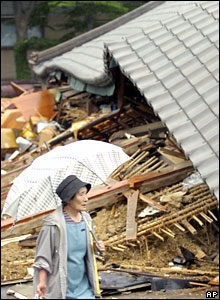
The city of Kashiwazaki was hardest
hit by a 6.8-magnitude earthquake
that struck central Japan on Monday. |
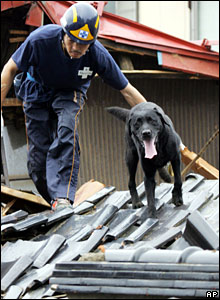
Rescuers are still searching
for survivors in collapsed
houses across the city. |
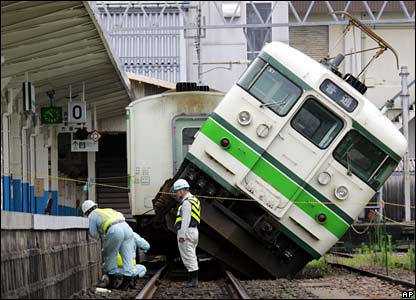
The public transport system
in Kashiwazaki has also been
severely disrupted |
|
Wednesday, July 18, 2007
TOKYO —
A total of 50 cases of
water leakage, fire and
other problems have
occurred at a nuclear
power plant in Niigata
Prefecture due to the
powerful earthquake that
hit the prefecture
Monday, Tokyo Electric
Power Co. said Tuesday.
|
|
|
|
Company Says Radioactive Leak Was Bigger
By ERIC TALMADGE
Associated Press
Writer
|
KASHIWAZAKI, Japan
(AP) -- A top power company official
defended safety standards at an
earthquake-ravaged nuclear plant
Wednesday, even as the company said a
radioactive leak was bigger than first
reported and the mayor ordered the plant
be shut down until its safety could be
confirmed.
Plant operator Tokyo
Electric Power Co. announced that a leak
of radioactive water into the Sea of Japan
was actually 50 percent bigger than
initially announced Monday night. But the
levels were still well below danger
levels, it said.
"We made a mistake
in calculating the amount that leaked into
the ocean. We apologize and make
correction," the statement said. Spokesman
Jun Oshima said the amount was still
"one-billionth of Japan's legal limit."
Hiroshi Aida, mayor
of Kashiwazaki, a city near the epicenter
that is home to the plant and 93,500
people, ordered operations at the plant
halted Wednesday for "safety reasons."
"I am worried," he
said. "It would be difficult to restart
operations at this time. ... The safety of
the plant must be assured before it is
reopened."
The International
Atomic Energy Agency, meanwhile, pressed
Japan to undertake a transparent and
thorough investigation of the accidents to
see if there are lessons that can be
applied to nuclear plants elsewhere in the
world.
Adding to the
urgency was new data from aftershocks of
Monday's deadly 6.8-magnitude quake
suggesting a fault line may run underneath
the mammoth power plant.
Kashiwazaki-Kariwa
is the world's largest nuclear plant in
power output capacity. Signs of problems
after Monday's quake came first not from
the officials, but in a plume of smoke
that rose up when the quake triggered a
small fire at an electrical transformer.
It was announced
only 12 hours later that the quake also
caused a leak of about 315 gallons of
water containing radioactive material.
Officials said the water leak was well
within safety standards. The water was
flushed into the sea.
Later Tuesday, it
said 50 cases of "malfunctioning and
trouble" had been found. Four of the
plant's seven reactors were running at the
time of the quake, and they were all shut
down automatically by a safety mechanism.
Tsunehisa Katsumata,
president of plant operator Tokyo Electric
Power Co., toured the site Wednesday
morning, declaring it "a mess" and
apologizing for "all the worry and trouble
we have caused."
"It is hard to make
everything go perfectly," he said. "We
will conduct an investigation from the
ground up. But I think fundamentally we
have confirmed that our safety measures
worked."
Speaking in
Malaysia, IAEA chief Mohamed ElBaradei
said a thorough review was key and offered
to have his Vienna-based agency pull
together global experts.
"It doesn't mean
that the reactor structure or system has
been damaged," ElBaradei said. "I would
hope and I trust that Japan would be fully
transparent in its investigation of that
accident. The agency would be ready to
join Japan through an international team
in reviewing that accident and drawing the
necessary lessons."
Meanwhile, TEPCO
spokesman Hiroshi Itagaki said that
information accumulated by studying
aftershocks shows that a fault line
stretches under the ocean near the coast,
which is not far away from the plant. He
declined to say how close to the plant the
fault might come, but the company is
planning to further study the issue.
Osamu Kamigaichi, an
official at Japan's Meteorological Agency,
which monitors earthquakes, said it was
possible the fault line stretched in the
direction of the nuclear facility and may
reach underneath its grounds.
Across town, more
than 8,000 residents hunkered down for
their second night in shelters. The death
toll - nine, with one person missing - was
not expected to rise significantly. Most
of the newer parts of town escaped major
damage.
For residents,
thousands of whom work at the plant, the
controversy over its safety compounded
already severe problems, which included
heavy rains and the threat of landslides,
water and power outages, and spotty
communications.
"Whenever there is
an earthquake, the first thing we worry
about is the nuclear plant. I worry about
whether there will be a fire or
something," said Kiyokazu Tsunajima, a
tailor who sat outside on his porch with
his family, afraid an aftershock might
collapse his damaged house.
"It's frightening,
but I guess we are used to it," said Ikuko
Sato, a young mother who was spending the
night in a crowded evacuation center near
her home, which was without water or
power.
"It's almost the
summer swimming season," she said. "I
wonder if it'll be safe to go in the
water."
The area around
Kashiwazaki was hit by an earthquake three
years ago that killed 67 people, but the
plant suffered no damage.
The malfunctions and
a delay in reporting them fueled concerns
about the safety of Japan's 55 nuclear
reactors, which have suffered a string of
accidents and cover-ups. Nuclear power
plants around Japan were ordered to
conduct inspections.
The plant in
Kashiwazaki-Kariwa, 135 miles northwest of
Tokyo, eclipsed a nuclear power station in
Ontario as the world's largest power
station when it added its seventh reactor
in 1997.
The Japanese plant,
which generates 8.2 million kilowatts of
electricity, has been plagued with
mishaps. In 2001, a radioactive leak was
found in the turbine room of one reactor.
The plant's safety
record and its proximity to a fault line
prompted residents to file lawsuits
claiming the government had failed to
conduct sufficient safety reviews when it
approved construction of the plant in the
1970s. But in 2005, a Tokyo court threw
out a lawsuit filed by 33 residents,
saying there was no error in the
government safety reviews.
Environmentalists
have criticized Japan's reliance on
nuclear energy as irresponsible in a
nation with such a vulnerability to
powerful quakes.
"This fire and
leakage underscores the threat of nuclear
accidents in Japan, especially in
earthquake zones," said Jan Beranek, a
Greenpeace official in Amsterdam. "In
principle, it's a bad idea to build
nuclear plants in earthquake-prone areas."
Japan has a history
of nuclear accidents, some of them deadly.
In 2004, five
workers at the Mihama nuclear plant in
western Japan were killed and six were
injured after a corroded pipe ruptured and
sprayed plant workers with boiling water
and steam. The accident was the nation's
worst at a nuclear facility.
The U.S. Nuclear
Regulatory Commission requires that
nuclear plants be built with the capacity
to withstand the strongest earthquake to
hit its site within 100 years. In a "safe
shutdown earthquake," the chain reaction
in the reactor stops, but the cooling
system keeps running so excess heat is
carried away from the core.
William Miller, a
professor of nuclear engineering at the
University of Missouri, said the
Kashiwazaki-Kariwa plant "did what it was
supposed to. It shut down."
Although its
operator said there were leaks, Miller
called the amounts he had heard were "so
small as to be negligible."
However, David
Lochbaum, director of the Nuclear Safety
Project at the Union of Concerned
Scientists, noted that fire and loss of
power, both of which occurred at
Kashiwazaki-Kariwa, are the two most
likely causes of meltdowns at nuclear
facilities.
---
Associated Press
writers Hiroko Tabuchi and Kozo Mizoguchi
in Tokyo and Sarah DiLorenzo in New York
contributed to this report.
© 2007 The
Associated Press. All rights reserved.
|
Wednesday,
July 18, 2007
KASHIWAZAKI —
More than 12,000 people were forced
to stay at evacuation shelters in
Niigata Prefecture on Tuesday as
power and water supplies remain cut
in most areas following a magnitude
6.8 earthquake the previous day
|
The death toll rose
to nine after 71-year-old Masako Iino, who
was pulled from the rubble of a collapsed
kimono shop in
Kashiwazaki
early Tuesday, was later pronounced
dead, while the number of injured
has topped 1,000.
One man is still missing in
Niigata Prefecture.
The Japan Meteorological Agency
warned that there is a 50 percent
probability of an aftershock with a
magnitude of 5 or higher occurring
in the next three days and a 30
percent chance of a magnitude 5.5
aftershock.
In Kashiwazaki, the quake
resulted in electricity failures
still affecting about 24,500 homes,
while more than 39,000 homes face
water disruptions. Gas supplies
remain cut at about 35,000 homes in
Kashiwazaki and Kariwa.
(KYODO) |
|
Death toll in Japan
earthquake rises to 10
|
| |
|
KASHIWAZAKI,
Japan, July 18, 2007 (Xinhua)
--
The death toll in a
major earthquake in central
Japan's Niigata prefecture
rose to ten late Wednesday,
with the finding of a man's
body in the rubble.
According to local
police, the body was found
under the rubble of a
collapsed temple in
Kashiwazaki, the most
heavily-hit city in Monday's
quake, where other nine
victims were found dead.
Besides, an old
man is still missing in
Kashiwazaki. The magnitude
6.8 quake has left over
1,000 people injured in
Niigata, Nagano and Toyama
prefectures.
According to
Chinese embassy in Japan, no
Chinese people have been
found injured during the
quake. Some 450 Chinese live
in the city of Kashiwazaki
by the end of 2006. To
assist Chinese residents,
the city started airing
information in Chinese
through radio on Wednesday,
which included instructions
on drinking water and trash
disposal.
Some 10,000 people
still stay in shelters in
disaster areas. Basic
utility services such as
drinking water, electricity
and gas have not been fully
restored.
|
|
|
EARTHQUAKE DATABASE
DREAMS OF THE
GREAT EARTHCHANGES - MAIN INDEX
PLANET PERFORMANCE.ORG
| | |
